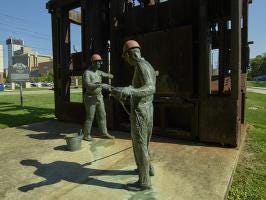I’m working from my hometown of Youngstown, Ohio this week. I had a little free time the other day and went to the Butler Institute of American Art, a small but mighty museum founded by Joseph Butler, financier to the steel industry, and supported by the steel families and their descendants. It was the first museum in the US dedicated to American art. The collection has a few masterpieces, such as Winslow Homer’s Snap the Whip. It also has some fun and quirky pieces, which reflect the work of American artists in the late 20th and early 21st century, and I suspect bring in people who don’t know a lot about art to the museum. (Admission is free, and yet, many people in town have never been there.)
Included in the Butler’s collection are the plaster casts used by George Segal to create a sculpture that currently stands outside the Youngstown Historical Center of Labor and Industry, The Steelmakers. It includes an actual open hearth from Republic Steel. The project began in the mid-1970s with an NEA grant to commission the piece. Several civic leaders were brought in to help oversee the grant, including my father. When Segal came to Youngstown, the mills were working and he was captivated by the sheer scale of the industry.
But there was a mismatch. When he shared his sketches and ideas, the committee heard “gleaming bronze celebration of industry” while Segal was thinking “show off the grit and hard work”. The steel mills started closing in 1977, in the midst of the work, which added a sense of urgency. People wanted to see their legacy honored in a time of so much pain. They wanted something tangible to show that it had all mattered.
It was a shock when the sculpture was revealed. The committee thought the blast furnace would be sandblasted; Segal loved it as it was. My father was there when the furnace was moved to the sculpture’s site in 1980; he came home and said that people were not going to be happy.
Instead of a shiny monument, there is a dirty blast furnace. The bronze figures of the workers aren’t polished; they have a rough finish. Rather than gleaming golden hard hats, the figures are topped in industrial orange. People were insulted, thinking that Segal was making fun of their pain and disrespecting their work. The night before the official dedication, the sculpture was graffitied. Shortly afterward, someone tried to dismantle it.
Eventually, the sculpture was taken down and moved into storage. In 2002, it was moved to the Center of Labor and Industry and rededicated. After Segal died, the Butler’s director wrote Segal’s widow to see if the casts were still around. They were, she donated them to the museum, and I saw them yet again this week.
So here’s my question: what is the best way to honor hard work? Should it be portrayed as beautiful and heroic, or is it better to show the ugliness and grit? Did Segal honor the workers or betray them?
Fun fact: a lot of people were also offended by Bruce Springsteen’s Youngstown. Who was this rich rock star to tell their story? People came around though, in part because Springsteen did a concert in Youngstown.






I find beauty in the grit.
A good friend will be having a solo show at the butler sometime in the next year--that was the first I heard of the museum. Hoping to get to the opening and looking forward to to seeing the museum .